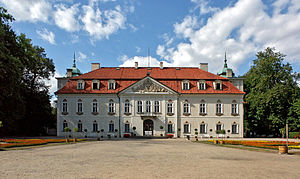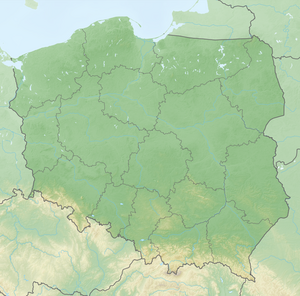Nieborów Castle
| Nieborów | ||
|---|---|---|
|
Facade - park side |
||
| Creation time : | after 1694 | |
| Castle type : | Location | |
| Conservation status: | Receive | |
| Place: | Nieborów | |
| Geographical location | 52 ° 3 '59.7 " N , 20 ° 4' 12.8" E | |
|
|
||
Nieborów Castle is a castle in the homonymous village of Nieborów in Poland in the Łódź Voivodeship . The castle is also known for the important baroque garden .
history
Around 1324 there was a wooden manor house in the village. At the beginning of the 16th century a manor was built in a transitional style between Gothic and Renaissance . This courtyard was used until the end of the 17th century. The Nieborów estate was then owned by the Nieborowski family. They sold the estate in 1694 to the Primate of Poland, Cardinal Michael Stephan Radziejowski , who had a baroque palace and garden built here by the architect Tylman van Gameren , builder of the Royal Chapel in Gdansk .
After the cardinal's death, the property changed hands frequently, before it passed in 1774 to the art-loving Michał Hieronim Prince Radziwiłł, who later became voivode of Vilnius. Prince Radziwiłł had the palace decorated with furniture and works of art in the style of the time. He founded an extensive library with over 10,000 volumes, including incalibular prints from the 15th century and the oldest printed product in Poland. Prince Radziwiłł also set up an extensive picture gallery: he collected Dutch, German, Italian and Spanish paintings as well as portraits of Polish and foreign dignitaries. The copper engraving cabinet attached to the picture gallery contained between ten and twenty thousand sheets.
Prince Radziwiłł had Simon Gottlieb Zug create a regular French garden in front of the palace in the early 1770s. The same builder was also responsible for the redesign of some of the interiors in the early classical style in 1784 (yellow and green cabinets, voivodal bedrooms).
After the death of Michał Hieronim Radziwiłł in 1831, nobody took care of the castle anymore, as there was a dispute over the inheritance that had lasted for years. The estate was left to its own devices for ten years, then, in 1841, Michał Hieronim's son, Michał Gedeon Prince Radziwiłł, took over Nieborów. Michał Gedeon Radziwiłł was a general and one of the chief commanders of the Polish November uprising of 1831. After his death, the estate passed into the possession of his son Zygmund Prince Radziwiłł. However, this turned out to be a serious wasteful and gradually ruined Nieborów economically. To get money, he had the best part of the picture gallery and library auctioned off in Paris. He also sold Arkadia with his valuable works of art to strange hands. Fortunately, Zygmund Radziwiłł ceded the estate to his nephew Michał Piotr Radziwiłł in 1879 and emigrated to France. The new owner bought Arkadia back and founded a majolica factory in 1881 , which also equipped the castle with decorative tiled stoves and art ceramics. A furniture manufacturer was also founded at that time. Michał Piotr Radziwiłł also endeavored to supplement the library's holdings through new purchases. He died childless in 1903. His widow sold Nieborów three years later to a distant cousin, Janusz Radziwiłł. He was a politician from the interwar period and had the interior of the castle partially rebuilt in the years 1922–1929, including the Venetian Hall and the smoking room. He made Nieborów a fashionable meeting place, which was visited by politicians and representatives of high society. Janusz Radziwiłł remained in the possession of Nieborów until February 1945. Then the family was abducted by the NKVD and taken to a camp near Krasnogorsk , where Janusz Radziwiłł's wife died. He himself was able to return to Warsaw in 1947, but the palace and the garden ensemble of Nieborów and Arkadia had already been nationalized and opened to the public as a branch of the National Museum of Warsaw. Janusz Radziwiłł died in 1967.
Interiors of the castle
Main staircase
The main staircase got its present form in the 1860s. At that time the walls were covered with blue Dutch tiles, which had been made around 1700 in the Harlingen factory , a branch in Delft . Portraits of the Kings Stanisław August Poniatowski , Johann III. Sobieski and his wife Johanna Kasimira with their son Jakob.
Green cabinet
The current interior dates from 1784 and was designed by Simon Gottlieb Zug. The room is furnished with English furniture.
Voivod bedroom
In the bedroom, the portrait of Aniela Radziwiłł by Élisabeth Vigée-Lebrun catches the eye.
Yellow cabinet
Like the Green Cabinet, the Yellow Cabinet has early Classicist furnishings by Zug from 1784, as well as antique-style ceiling paintings.
White hall
The White Hall was the ballroom of the palace, which was also used as the palace chapel. The imaginative stucco comes from three construction periods: from the last quarter of the 18th century (reconstruction of the hall by Zug), from the middle of the 19th century and from the reconstruction phase from 1927. The altar from 1784 is in a corner niche. The altar painting is by Hans Hoffmann , a famous imitator of Dürer .
Library
The library was originally the palace's picture gallery. Today there are 13 mahogany bookshelves from the time before 1817 - certainly made by local masters. Above the fireplace is a splendid portrait of Cardinal Michael Stephan Radziejowski, who built the palace. A portrait gallery of European rulers above the bookcases. Particularly noteworthy are the Venetian globes created by Vincenco Coronelli in the 17th century. The library's balcony offers a beautiful panorama.
Small dining room
The small dining room was furnished in the Neo-Rococo style under Michał Piotr Radziwiłł at the end of the 19th century.
Library cabinet
Polish furniture from the 18th century catches the eye in the library cabinet. The chandelier comes from the Saint Petersburg glass factory.
Red salon
The red salon has been able to keep its Rococo furnishings from the 1860s. The dominant accent is the portrait of Anna Karolina Countess Orzelska , an illegitimate daughter of King August II with Henriette Renard, which was created by the Prussian court painter Antoine Pesne .
The princely couple's bedroom and boudoir
The bedroom was designed in 1886 in the neo-coco style. The neighboring boudoir also received its neo-coco furnishings at the end of the 19th century.
Rooms on the ground floor
The first thing you notice on the ground floor is the stately hallway. With its dimensions and the vaulted ceiling, the room comes from the first building phase of the castle. The wall paneling made of black oak in the neo-renaissance style dates from 1885, as was the cladding of the fireplace. The hallway houses the famous head of Niobe , which was made in Rome in the 1st or 2nd century as a copy of a Greek model. The head is immortalized in a poem by the Polish poet Konstanty Ildefons Gałczyński . The Hellenistic corridor adjacent to the hall also serves as a storage space for ancient sculptures.
Castle garden
The baroque park was laid out by Simon Gottlieb Zug in the French style in the second half of the 18th century. On the south side of the castle there is a flower parterre and a box tree labyrinth. The park is criss-crossed by a wide avenue of lime trees with a lawn carpet that leads to the center of the palace. The main avenue ends with a Ha-Ha . To the west of the castle is a canal with an angular floor plan. It connects two ponds and separates the baroque garden from an adjoining English landscape garden. From 1947 the palace garden was restored by Gerard Ciołek.
The estate also includes several farm buildings, of which the orangery , horse stable, carriage shed and servants' houses have been preserved to this day. To the north of the castle there is still a hunting pavilion, which today houses guest rooms. The Nieborów majolica collection and the management of the museum's property are now located in the factory buildings.
literature
- Photos: Krzysztof Jabłoński, text: Włodzimierz Piwkowski: Nieborow. Pałac Radziwiłłów - The Radziwiłł Palace . Wydawnictwo Voyager, Warszawa 1992, ISBN 83-85496-03-3 .
- Krzysztof Jabłoński, Włodzimierz Piwkowski: Nieborów, Arkadia. Warszawa 1996, ISBN 83-7079-598-6 .
Movie
- This side of Eden. Eastern Europe's garden dreams in the 18th and 19th centuries - Arkadia Garden and Niebórow Castle, Poland. Documentary, Germany, 2015, 52 min., Book: Inga Wolfram and Helge Trimpert , director: Inga Wolfram, moderation: Wladimir Kaminer , production: telekult, MDR , arte , series: Diesseits von Eden , first broadcast: June 7, 2015 on arte
Web links
- Museum in Nieborów and Arkadia (Polish)
- Summary of the arte film
Individual evidence
- ↑ Ekhart Berckenhagen: Anton Graff - life and work. Deutscher Verlag für Kunstwissenschaft, Berlin 1967, p. 19.









